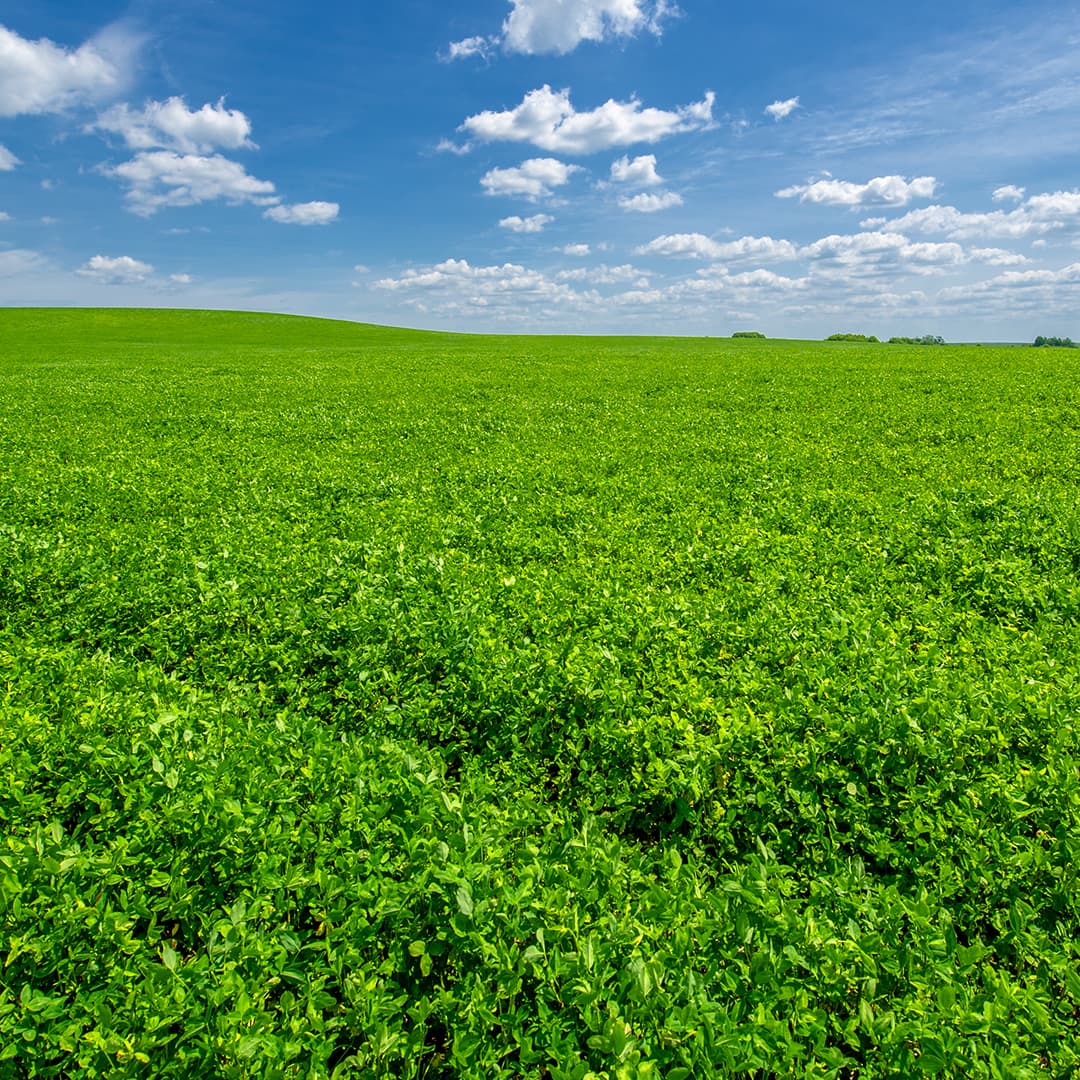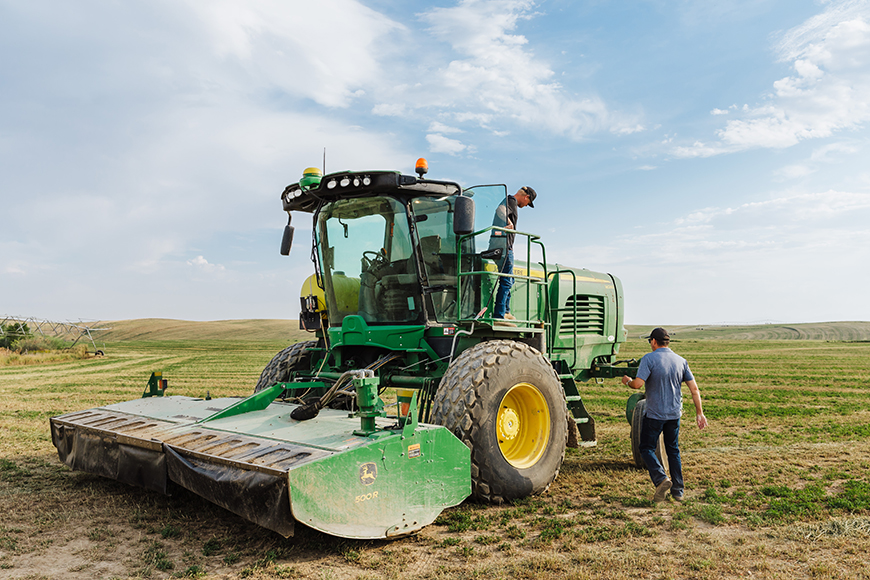Determining when to hop in the mower and head to the field is not a simple decision. Alfalfa harvest timing should be based on your unique operational goals and the nutrient needs of the animals you’re feeding.
Understanding Alfalfa Development
Alfalfa is at its highest quality when beginning regrowth, either in the spring or after mowing. However, at immature stages, yield is low and the plant has not replenished root reserves for regrowth. Alfalfa growers must balance the tradeoffs between plant needs for regrowth, yield and forage quality.
The graph below shows that root carbohydrates dip during growth initiation and reach the lowest point when alfalfa is 6 to 8 inches tall. After this point, the top growth can support its own development and produce additional carbohydrates to replenish root reserves.
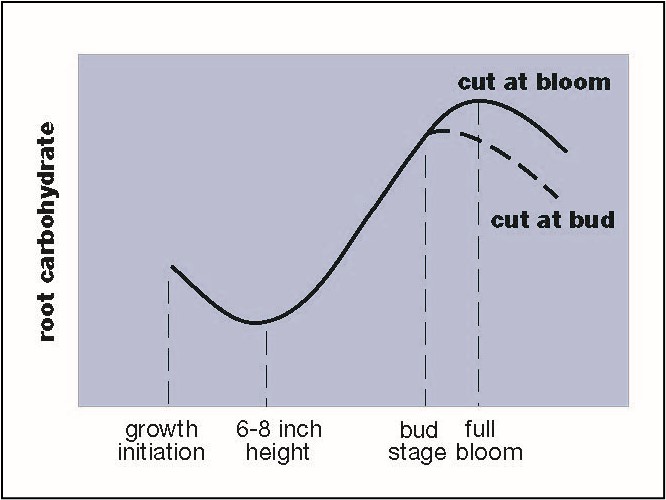
When alfalfa is harvested at the bud stage, it has not fully replenished its root reserves. This is why some recommend letting one harvest go to early bloom to allow root replenishment for less advanced varieties, which is another reason the reduced-lignin HarvXtra® alfalfa trait is so valuable. It can be harvested at the same quality up to 10 days later than conventional types, allowing greater root carbohydrate replenishment.
When To Harvest For Supreme Quality
When aiming for the former goal and prioritizing quality, animal requirements are generally the first consideration. Figure 1 gives an indication of the differing nutrient needs based on animal production status and how that can correspond to forage quality when using relative forage quality (RFQ).
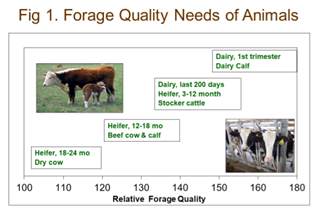
With conventional and Roundup Ready® alfalfa varieties, it is important to harvest on a shorter harvest interval to capture improved digestibility and keep fiber content low. Shorter harvest intervals also help ensure higher overall crude protein levels to meet the demands of lactating and growing cattle.
When To Harvest For Higher Yield
Harvesting for maximum yield often comes with a tradeoff in forage quality, as forages including alfalfa will decline in digestibility and other nutrients while increasing in fiber and lignin as they mature (Figure 2). However, in that exchange, the plant will accumulate more biomass until the plant reaches about 50% flower.
Generally speaking, bud stage is dairy-quality hay. This is when alfalfa yield is about 80% of full potential but the increased nutrients lead to enhanced milk production that makes up for the yield loss. Those producing hay for the beef or even horse markets may wait until 25-50% bloom to capture increased yield since those animals do not need as high a quality to meet their nutritional demands.
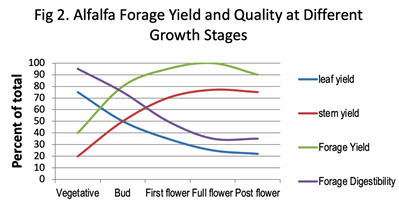
Harvest Recommendations Based On Animal
Animal nutrient needs depend primarily on age, sex and production status. Maximum ROI potential comes from matching forage quality to animal needs. Lower than optimum quality results in either reduced animal performance or increased supplement costs. Conversely, feeding animals higher quality forage than they need wastes unused nutrients that were expensive to produce and may result in animal health problems. If you’re growing conventional or Roundup Ready alfalfa varieties, follow these guidelines to optimize yield and quality based on the animals you intend to feed.
- For Dairy: Cut at bud stage or 27 inches in height, whichever comes first. If you mixed grass with the alfalfa, you may want to harvest when the grass begins to head out. Most dairy producers harvest on a 25-28 day harvest schedule, depending on the area.
- For Growing Animals, Beef and Horses: Cut at early flower or 32 inches in height, whichever comes first. Don’t wait too long to harvest, as increased risk of lodging may occur with heavy rains if left in the field for too long. For later alfalfa cuttings, you may have a slightly longer window to work with but center your timing on your animals’ nutrition needs. You can extend your harvest interval slightly, between 30-32 days, depending on location and animal needs.
Regardless of the species you feed, regularly monitor your forage with forage quality analyses to ensure your forage is meeting your animals’ production needs.
Take care if utilizing any traited technology, as the signed Technology Stewardship Agreement (TSA) states that in alfalfa seed production areas, traited alfalfa must be harvested at or before 10% bloom and that in all other areas it must be harvested prior to 50% bloom.
When To Harvest HarvXtra Alfalfa
If utilizing HarvXtra alfalfa, you have increased flexibility in your harvest interval because forage quality will not decline at the same rate. Harvest first cutting HarvXtra alfalfa with the same criteria as conventional alfalfa. The forage will be slightly higher quality but, if left longer on first cutting, the alfalfa will lodge as any conventional variety would.
For subsequent cuttings, you can optimize your forage quality even further if choosing to remain on the same harvest schedule you would have with conventional alfalfa. This can lead to improvements in animal performance if alfalfa is fed at significant amounts in the ration.
If choosing to optimize yield, you can again delay harvest up to 10 days and still have high-quality forage comparable to conventional harvested up to 10 days prior. This also gives you harvest flexibility in case of rain delays, which is often an inevitable occurrence for many farmers.
Work with your local W-L Alfalfas® dealer to identify the cutting schedule that makes most sense for your alfalfa genetics and production goals.
© 2023 Forage Genetics International, LLC. HarvXtra® and W-L Alfalfas® are registered trademarks of Forage Genetics International, LLC. All other trademarks are property of their respective owners.
Understanding Alfalfa Development
Alfalfa is at its highest quality when beginning regrowth, either in the spring or after mowing. However, at immature stages, yield is low and the plant has not replenished root reserves for regrowth. Alfalfa growers must balance the tradeoffs between plant needs for regrowth, yield and forage quality.
The graph below shows that root carbohydrates dip during growth initiation and reach the lowest point when alfalfa is 6 to 8 inches tall. After this point, the top growth can support its own development and produce additional carbohydrates to replenish root reserves.

When alfalfa is harvested at the bud stage, it has not fully replenished its root reserves. This is why some recommend letting one harvest go to early bloom to allow root replenishment for less advanced varieties, which is another reason the reduced-lignin HarvXtra® alfalfa trait is so valuable. It can be harvested at the same quality up to 10 days later than conventional types, allowing greater root carbohydrate replenishment.
When To Harvest For Supreme Quality
When aiming for the former goal and prioritizing quality, animal requirements are generally the first consideration. Figure 1 gives an indication of the differing nutrient needs based on animal production status and how that can correspond to forage quality when using relative forage quality (RFQ).

With conventional and Roundup Ready® alfalfa varieties, it is important to harvest on a shorter harvest interval to capture improved digestibility and keep fiber content low. Shorter harvest intervals also help ensure higher overall crude protein levels to meet the demands of lactating and growing cattle.
When To Harvest For Higher Yield
Harvesting for maximum yield often comes with a tradeoff in forage quality, as forages including alfalfa will decline in digestibility and other nutrients while increasing in fiber and lignin as they mature (Figure 2). However, in that exchange, the plant will accumulate more biomass until the plant reaches about 50% flower.
Generally speaking, bud stage is dairy-quality hay. This is when alfalfa yield is about 80% of full potential but the increased nutrients lead to enhanced milk production that makes up for the yield loss. Those producing hay for the beef or even horse markets may wait until 25-50% bloom to capture increased yield since those animals do not need as high a quality to meet their nutritional demands.

Harvest Recommendations Based On Animal
Animal nutrient needs depend primarily on age, sex and production status. Maximum ROI potential comes from matching forage quality to animal needs. Lower than optimum quality results in either reduced animal performance or increased supplement costs. Conversely, feeding animals higher quality forage than they need wastes unused nutrients that were expensive to produce and may result in animal health problems. If you’re growing conventional or Roundup Ready alfalfa varieties, follow these guidelines to optimize yield and quality based on the animals you intend to feed.
- For Dairy: Cut at bud stage or 27 inches in height, whichever comes first. If you mixed grass with the alfalfa, you may want to harvest when the grass begins to head out. Most dairy producers harvest on a 25-28 day harvest schedule, depending on the area.
- For Growing Animals, Beef and Horses: Cut at early flower or 32 inches in height, whichever comes first. Don’t wait too long to harvest, as increased risk of lodging may occur with heavy rains if left in the field for too long. For later alfalfa cuttings, you may have a slightly longer window to work with but center your timing on your animals’ nutrition needs. You can extend your harvest interval slightly, between 30-32 days, depending on location and animal needs.
Regardless of the species you feed, regularly monitor your forage with forage quality analyses to ensure your forage is meeting your animals’ production needs.
Take care if utilizing any traited technology, as the signed Technology Stewardship Agreement (TSA) states that in alfalfa seed production areas, traited alfalfa must be harvested at or before 10% bloom and that in all other areas it must be harvested prior to 50% bloom.
When To Harvest HarvXtra Alfalfa
If utilizing HarvXtra alfalfa, you have increased flexibility in your harvest interval because forage quality will not decline at the same rate. Harvest first cutting HarvXtra alfalfa with the same criteria as conventional alfalfa. The forage will be slightly higher quality but, if left longer on first cutting, the alfalfa will lodge as any conventional variety would.
For subsequent cuttings, you can optimize your forage quality even further if choosing to remain on the same harvest schedule you would have with conventional alfalfa. This can lead to improvements in animal performance if alfalfa is fed at significant amounts in the ration.
If choosing to optimize yield, you can again delay harvest up to 10 days and still have high-quality forage comparable to conventional harvested up to 10 days prior. This also gives you harvest flexibility in case of rain delays, which is often an inevitable occurrence for many farmers.
Work with your local W-L Alfalfas® dealer to identify the cutting schedule that makes most sense for your alfalfa genetics and production goals.
© 2023 Forage Genetics International, LLC. HarvXtra® and W-L Alfalfas® are registered trademarks of Forage Genetics International, LLC. All other trademarks are property of their respective owners.

